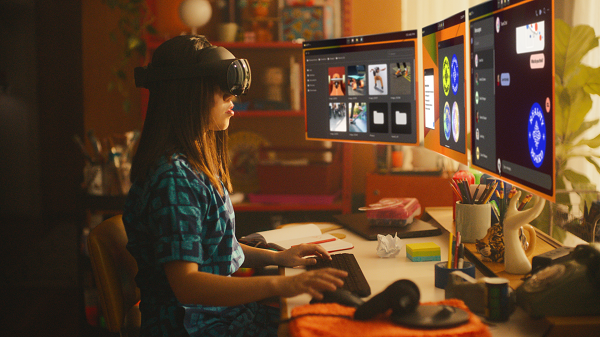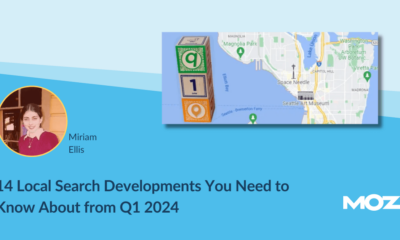SOCIAL
Meta Showcases Latest VR Developments at Connect 2022, Including New Quest Pro Headset

Meta is holding its Connect conference for 2022 today, where it’s announced a range of new, cutting-edge VR features, including a new Quest headset, new professional integrations to facilitate workplace collaboration, updated interaction tools, control devices, and this…
Yes, soon, your VR avatar will actually have legs, so you won’t look like the genie from Aladdin floating around Meta’s VR spaces.
Here’s a look at the key updates from the event:
First off, Meta’s releasing a new, upgraded version of its standalone Quest VR headset, with the Quest Pro, the next evolution in VR interaction.
As explained by Meta:
“Meta Quest Pro is the first entry in our new high-end line of devices, and it’s packed with innovative features like high-res sensors for robust mixed reality experiences, crisp LCD displays for sharp visuals, a completely new and sleeker design, plus eye tracking and Natural Facial Expressions to help your avatar reflect you more naturally in VR.”
The Quest Pro, which as originally titled ‘Project Cambria’, is also able to display 37% more pixels per inch, which will make the VR experience more immersive, and more realistic – which could be a good and bad thing (some of them VR rollercoasters genuinely make me feel sick).
The advanced device will also facilitate a range of new professional features, including multi-screen display, workrooms for collaboration in VR, ‘Magic Rooms’, which will combine VR and video participants, and more.
Even more than this, Meta also announced a new partnership with Microsoft that will see the two tech giants working together on a range of professional integrations, including Microsoft Teams immersive meeting experiences, and the integration of Microsoft’s top apps, including Word, Excel, etc.
It all seems potentially valuable, and another step towards the future of VR interaction.
But it’ll cost ya’.
Meta’s Quest Pro is now available for pre-sale at a whopping $US1,499. For comparison, the current best-selling standalone VR headset, Meta’s Quest 2, sells for $US399.
Meta’s been dealing with various challenges in getting the components and processes in place for its VR supply chain, which already forced it to increase the price of the Quest unit by $US100 back in August. But even with that in mind, an almost 4x increase in price is a huge leap, which will likely leave the Pro version as a theoretical concept for most regular consumers.
But then again, as the name suggests, the real focus here is on professional use, and integrating VR in all new ways. Meta also notes that it’s working with Accenture, Autodesk and Adobe, among others, in helping them build VR into their processes, and guide their staff, and clients, into the next phase of professional collaboration.
The Quest Pro will start shipping from October 25th – more info here.
Meta also announced that it’s developing Horizon Worlds on the web ‘so you can eventually pick up your phone or laptop and visit friends who are hanging out in VR, and vice versa’.
Meta’s been looking for more ways to integrate additional access points and interaction options for VR, which would essentially enable you to use your VR avatars in various online spaces, not just in the VR realm. That’s part of the broader view of the fully integrated metaverse, that people on various devices, and in various apps, will be able to tap into the metaverse experience, even without a VR headset.
Interestingly, Meta also noted that it’s working with the YouTube VR team to build more engaging entertainment experiences in VR spaces, like hosting YouTube watch parties in Horizon Home.
And again, avatars with legs:

Meta says that its new full-body VR avatars will roll out to Horizon Worlds shortly, while users will also soon be able to use these new avatars in video chat, on Messenger and WhatsApp too.
Meta also previews its latest advances in electromyography, which will eventually enable more control over AR and VR experiences by detecting actions in your wrist, Project Aria, its AR glasses project, which it’s now developing to assist people with visual impairments, and new process to build 3D objects in VR spaces.
And after Zuckerberg got lambasted for his now infamous metaverse photo back in August, he also shared the latest developments in its photorealistic Codec Avatars, which are far from being an accessible option for regular users, but do show where we could be headed, in terms of digital representation.
Meta introduces a new version of Mark Zuckerberg, who is a lot more expressive, capable of non-verbal cues like raising an eyebrow and squinting pic.twitter.com/La7KTd2ibc
— Jane Manchun Wong (@wongmjane) October 11, 2022
Meta’s been working on these for some time, but a key impediment to widespread adoption and usage is that it requires a lot of specialized scanning equipment, and computer power, to build these more realistic depictions.
Eventually, Meta could look to install VR scanning units in accessible places to facilitate such (potentially even Meta stores if it expands its retail operations), and you could soon have some pretty amazing options for display and engagement within the virtual space.
Overall, it’s an interesting showcase of where Meta is headed with its VR developments, and its broader metaverse push. But then again, there’s nothing truly mind-blowing, as such, here – there’s nothing that’s going to help shift perceptions of Zuck’s metaverse investment as a huge potential waste of money, because there’s nothing that regular people can take away and apply to their lives every day, or nothing that transforms the VR or metaverse experience right now.
Instead, Meta’s looking to merge its VR tools into professional applications instead, in the hopes that this will broader VR adoption, through advanced system usage at work to begin with.
That makes some sense. Business users are more likely to pay more for these advanced experiences, and if more people are using VR at work, that could expedite the broader shift towards metaverse interaction in your social life too.
But it’ll be interesting to see the market reactions to Zuck’s latest VR showcase, and whether it’ll be enough to shake off the negative perceptions of the metaverse, which seem to be gaining more momentum every day.
SOCIAL
Snapchat Explores New Messaging Retention Feature: A Game-Changer or Risky Move?

In a recent announcement, Snapchat revealed a groundbreaking update that challenges its traditional design ethos. The platform is experimenting with an option that allows users to defy the 24-hour auto-delete rule, a feature synonymous with Snapchat’s ephemeral messaging model.
The proposed change aims to introduce a “Never delete” option in messaging retention settings, aligning Snapchat more closely with conventional messaging apps. While this move may blur Snapchat’s distinctive selling point, Snap appears convinced of its necessity.
According to Snap, the decision stems from user feedback and a commitment to innovation based on user needs. The company aims to provide greater flexibility and control over conversations, catering to the preferences of its community.
Currently undergoing trials in select markets, the new feature empowers users to adjust retention settings on a conversation-by-conversation basis. Flexibility remains paramount, with participants able to modify settings within chats and receive in-chat notifications to ensure transparency.
Snapchat underscores that the default auto-delete feature will persist, reinforcing its design philosophy centered on ephemerality. However, with the app gaining traction as a primary messaging platform, the option offers users a means to preserve longer chat histories.
The update marks a pivotal moment for Snapchat, renowned for its disappearing message premise, especially popular among younger demographics. Retaining this focus has been pivotal to Snapchat’s identity, but the shift suggests a broader strategy aimed at diversifying its user base.
This strategy may appeal particularly to older demographics, potentially extending Snapchat’s relevance as users age. By emulating features of conventional messaging platforms, Snapchat seeks to enhance its appeal and broaden its reach.
Yet, the introduction of message retention poses questions about Snapchat’s uniqueness. While addressing user demands, the risk of diluting Snapchat’s distinctiveness looms large.
As Snapchat ventures into uncharted territory, the outcome of this experiment remains uncertain. Will message retention propel Snapchat to new heights, or will it compromise the platform’s uniqueness?
Only time will tell.
SOCIAL
Catering to specific audience boosts your business, says accountant turned coach

While it is tempting to try to appeal to a broad audience, the founder of alcohol-free coaching service Just the Tonic, Sandra Parker, believes the best thing you can do for your business is focus on your niche. Here’s how she did just that.
When running a business, reaching out to as many clients as possible can be tempting. But it also risks making your marketing “too generic,” warns Sandra Parker, the founder of Just The Tonic Coaching.
“From the very start of my business, I knew exactly who I could help and who I couldn’t,” Parker told My Biggest Lessons.
Parker struggled with alcohol dependence as a young professional. Today, her business targets high-achieving individuals who face challenges similar to those she had early in her career.
“I understand their frustrations, I understand their fears, and I understand their coping mechanisms and the stories they’re telling themselves,” Parker said. “Because of that, I’m able to market very effectively, to speak in a language that they understand, and am able to reach them.”Â
“I believe that it’s really important that you know exactly who your customer or your client is, and you target them, and you resist the temptation to make your marketing too generic to try and reach everyone,” she explained.
“If you speak specifically to your target clients, you will reach them, and I believe that’s the way that you’re going to be more successful.
Watch the video for more of Sandra Parker’s biggest lessons.
SOCIAL
Instagram Tests Live-Stream Games to Enhance Engagement

Instagram’s testing out some new options to help spice up your live-streams in the app, with some live broadcasters now able to select a game that they can play with viewers in-stream.
As you can see in these example screens, posted by Ahmed Ghanem, some creators now have the option to play either “This or That”, a question and answer prompt that you can share with your viewers, or “Trivia”, to generate more engagement within your IG live-streams.
That could be a simple way to spark more conversation and interaction, which could then lead into further engagement opportunities from your live audience.
Meta’s been exploring more ways to make live-streaming a bigger consideration for IG creators, with a view to live-streams potentially catching on with more users.
That includes the gradual expansion of its “Stars” live-stream donation program, giving more creators in more regions a means to accept donations from live-stream viewers, while back in December, Instagram also added some new options to make it easier to go live using third-party tools via desktop PCs.
Live streaming has been a major shift in China, where shopping live-streams, in particular, have led to massive opportunities for streaming platforms. They haven’t caught on in the same way in Western regions, but as TikTok and YouTube look to push live-stream adoption, there is still a chance that they will become a much bigger element in future.
Which is why IG is also trying to stay in touch, and add more ways for its creators to engage via streams. Live-stream games is another element within this, which could make this a better community-building, and potentially sales-driving option.
We’ve asked Instagram for more information on this test, and we’ll update this post if/when we hear back.
-

 SEARCHENGINES6 days ago
SEARCHENGINES6 days agoGoogle Core Update Volatility, Helpful Content Update Gone, Dangerous Google Search Results & Google Ads Confusion
-

 SEO6 days ago
SEO6 days ago10 Paid Search & PPC Planning Best Practices
-

 MARKETING7 days ago
MARKETING7 days ago2 Ways to Take Back the Power in Your Business: Part 2
-

 MARKETING5 days ago
MARKETING5 days ago5 Psychological Tactics to Write Better Emails
-

 SEARCHENGINES5 days ago
SEARCHENGINES5 days agoWeekend Google Core Ranking Volatility
-

 SEO6 days ago
SEO6 days agoWordPress Releases A Performance Plugin For “Near-Instant Load Times”
-

 MARKETING6 days ago
MARKETING6 days agoThe power of program management in martech
-
SEARCHENGINES4 days ago
Daily Search Forum Recap: April 15, 2024













You must be logged in to post a comment Login